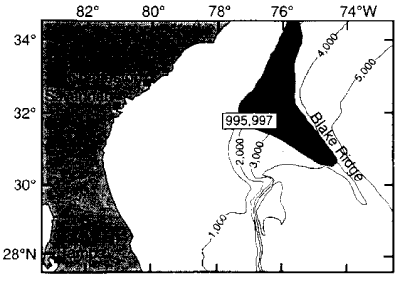 |
Science Frontiers ONLINE No. 111: May-Jun 1997 |
|
|
Methane Burps And Gas-hydrate Reservoirs
Readers will be forgiven for any skepticism they may harbor about methane burps from the sea floor bringing down TWA flight 800. (SF#110) The media have said little about the staggering quantities of methane and higher hydrocarbons locked up in frozen hydrates around the edges of the continents. Actually, the small methane burps are minor problems compared to the catastrophic climate changes that could be forced if just a small portion of the gases frozen under the sea floor were released into the atmosphere.
Gas-hydrates are unimpressive when brought to the surface -- just dirty, fizzy ice. However, taken together, they contain more carbon than all the world's oil fields, perhaps much more. Most estimates fall between 1,700 and 11,000 billion tons, but there is one scientist who pegs these cold-storage carbon deposits at 4,100,000 billion tons. In comparison, human releases of carbon to the atmosphere via the burning of wood, gas, coal, and even the collective flatulence of all the planet's animals are trivial.
Geological evidence confirms that past climate swings were associated with large injections of carbon into the atmosphere and oceans. A major contributor to these "carbon burps" may be decomposing methane hydrate. Until recently, climatologists have questioned the sizes of gas-hydrate deposits, but cores extracted from the Blake Ridge off the Carolina coast confirm the immense amounts of gases precariously locked up in sea-floor sediments.
The stratum of gas hydrates in the Blake Ridge alone covers 26,000 square kilometers -- enough gas is there to supply the U.S. for 107 years. In biological terms the Blake Ridge's carbon is equal to 7% of the carbon locked up in all terrestrial biota -- animals, trees, grasses, etc. And the Blake Ridge gas hydrates represent a miniscule fraction of the planet's frozen gas hydrates.
(Dickens, Gerald R., et al; "Direct Measurement of In Situ Methane Quantities in a Large Gas-Hydrate Reservoir," Nature, 385:426, 1997. Also: MacDonald, Ian R.; "Bottom Line for Hydrocarbons," Nature, 385:389, 1997.)
Comment. Methane is well-known as a "greenhouse gas." If really large "burps" were released, climatic changes would probably ensue. Unfortunately, gashydrates are rather unstable. What would happen if a large asteroid slammed into the Blake Ridge? Huge quantities of methane would disgorge into the earth's atmosphere. The climate changes might be disastrous for fauna (like the dinosaurs!) and flora.
 | The heavily shaded area of the Blake Ridge (area = 26,000 km2) contains gas-hydrates and free gas. Drill sites 995 and 997 are also indicated. |